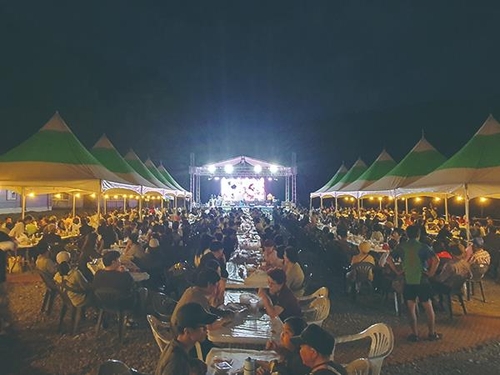"A Stage Built by the Audience" — Kkangchon Night Returns
Kkangchon night returns — this time with music.
At 6:00 p.m. on August 23, 2025, a small speaker was turned on in the front yard of the Kkangchon Cultural Center in Gaechon‑5‑ri, Bangnim‑myeon, Pyeongchang. (Kkangchon is a Korean word for a very small rural village.)
The eighth annual Gaechon 5‑ri Kkangchon Music Night had begun.
Photographs by reporter Im Bo‑yeon captured faces leaning into the dark with quiet expectation.
The expressions of people gathered in the village square were layered and complex.
Local residents and newcomers who moved to the countryside stood near the stage, and children ran and played beside farm tools.
That scene moves at a different pace than a city festival — slower and more intimate.
In that sense, the Gaechon event is an attempt to restore a rhythm of communal life.
Why is this debate so heated now?
Start with one question: is this kind of event sustainable?
Local reactions are split — some welcome the festival, others worry.
The county office and residents share costs, but securing an annual budget remains a recurring challenge.
Meanwhile, supporters say the concert has become a vital thread tying the village back together.
The Gaechon 5‑ri music night began around 2018 and reached its eighth edition in 2025.
After the Kkangchon Cultural Center opened in 2023, the number of performances and educational programs increased, and the center began to be seen as a local cultural hub.
Linking the event to the Gaechon Classical Festival — organized with the Jung Mong‑koo Foundation (a private foundation linked to Hyundai Motor Group) and Korea National University of Arts — may have helped activate regional cultural life.
On the other hand, some warn that without financial independence, the festival's identity could be at risk.
A small ripple that made a big wave

Paint the evening again: the village at dusk becomes a stage.
The Gaechon 5‑ri music night reads as an example of a rural community creating its own cultural space.
The concert has become more than a performance; it is a place where village memories and stories gather.
Behind the stage, neighbors move equipment; in the kitchen, families prepare dinner — daily life and festival fold into one another.
That process has ripple effects on the local economy.
Visitors bring short‑term boosts to lodging, restaurants, and farm stalls where residents sell produce directly.
However, demand concentrated in a single period is hard to turn into long‑term growth.
In that way, a small ripple raises both local hopes and outside expectations.
Weighing the costs and gains
Gains and burdens are balanced on a knife edge.
Proponents argue the Gaechon music night strengthens community ties and helps new rural residents settle in.
In participant interviews, the line ‘‘the concert helped us share our hearts with neighbors’’ appeared again and again.
One villager said, "Seeing children shout and run is the village's energy."
Yet the concerns of critics also carry weight.
Maintaining festival frequency and scale without clear financial sustainability can become a burden for local government and residents.
Aging populations and falling numbers make it hard for short‑term events to solve structural problems.
On the other hand, heavy reliance on outside funding or corporate sponsorship risks diluting a distinct local identity.
Historical comparisons matter.
Some rural cultural festivals start strong but shrink over time because of budget shortfalls and staffing gaps; that pattern is a warning.
Meanwhile, there are examples where resident‑led management combined with local resources created enduring initiatives, so the outcome is not predetermined.
Therefore this debate is less about simple for‑or‑against positions and more about designing a viable model for sustainability.
Pyeongchang faces a choice
The conclusion is not settled yet.
The Gaechon 5‑ri music night has shown the potential of a community‑led cultural event, but it needs structural fixes to continue.
Suggestions include finding a public‑private funding balance, encouraging participation across generations, and diversifying artistic genres to broaden appeal.
Meanwhile, linking arts education to local assets and building a medium‑ to long‑term cultural strategy are important next steps.
The core is local agency.
External support and networks matter, but building the community's own capacity to plan and run events may be the key to survival.
The next task is to craft plans that preserve local identity while welcoming a variety of tastes.
Ask yourself: if this were your town, what would you choose?
The Gaechon 5‑ri Kkangchon Music Night began around 2018 and reached its eighth edition in 2025. After the opening of the Kkangchon Cultural Center in 2023, the event has grown toward becoming a local cultural center.
The music night contributes to community building, supports newcomers settling in rural life, and brings short‑term economic activity.
However, practical challenges remain: financial strain, limited participation due to aging and depopulation, and concerns about overcommercialization.
In short, balancing outside support with local leadership and developing a long‑term cultural strategy are the tasks ahead. Communities should reconsider what choices best fit their future.